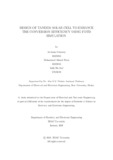Design of tandem solar cell to enhance the conversion efficiency using FDTD simulation
Abstract
One of the major problem the world is facing today is the scarcity of the resources to
produce electrical energy using non-renewable resources. To overcome this limitation, renewable energy sources such as solar energy are the best alternative. Hence,
solar cells are used to convert this bulk amount of energy into electrical energy. The
maximum efficiency obtained for a six-junction III-V tandem solar cell is around
47%. However, to obtain the mentioned efficiency is costly as the fabrication process is complex. Therefore, a two-junction III-V tandem solar cell is designed with
Indium Phosphide (InP) as the base material. This design would be much simpler
as there are less materials used and the complexity is thus reduced. The research
consisted of couple of finite difference time domain (FDTD) simulations to analyze
the optical properties by changing the physical parameter like varying the material
of the substrate (GaAs/InP). Upon getting the best results, the proposed model is
constructed which an improved absorption due to the material has used. Besides,
the CHARGE simulation also yielded better current density of 39.1479 mA/cm2
and an increased conversion efficiency of 36.9373 %.

